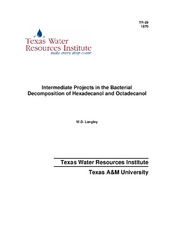| dc.description.abstract | Water resource planning, development, and utilization encompass the concerns of water quantity and water quality. In a given location a sufficient quantity of water is required to sustain community human activities, provide for industrial use, and allow for agricultural needs. The quality of water must generally be safeguarded in order that community health will not be endangered, that the water will be suitable for recreational purposes, that wildlife will be sustained, that the water will not be rendered unfit for agricultural requirements, or that it will not require extensive treatment for industrial use. Depending on the area of the country, one or the other of these concerns may be dominant. For example, in the Northeast and upper Midwest, an excess of water has been naturally provided which has allowed the development of large population and industrial centers. But the long term and recently accelerated return of water-borne wastes from these centers to water bodies has caused a critical deterioration of water quality. In the arid Southwestern region of the Uni ted States, the lack of a large natural supply of water and only moderate annual rainfall have retarded the development of the area for both industrial and agricultural purposes. Clearly, the development and maintenance of a sufficient quantity of water has been the dominant concern of this region.
The increased emphasis on conservation and optimum utilization of our water resources has generated a multiplicity of research efforts to define and suppress the factors which work toward waste or destruction of these resources. In the arid climate of the Southwest, control of water loss by evaporation from impoundments would constitute a major step in suppressing waste, consequently a considerable research effort has been directed toward the investigation of monolayer films on the surface of small reservoirs in attempts to minimize loss by the evaporation process. On the other hand research efforts designed to prevent the destruction of these resources have been concerned with the effects of foreign chemical components on the ecological regimes within the reservoir system. Such research efforts are not contradictory but should rather be complementary if a total understanding is to be gained of the physical, chemical, and biological implications of alteration of a natural process.
When evaporation suppression is achieved by monolayer surface filming, a substance foreign to the water is applied, admittedly in very small quantity relative to the quantity of water in the reservoir. Physical, chemical, or biological forms may then set in to disrupt the film or bring about the disappearance of the added chemical. It is therefore necessary, in order to maintain film integrity, to apply on a continuous or continual basis. Conceivably the eventual application of chemicals might attain a significant level relative to the water, particularly in a small reservoir of low volume to surface area ratio. The chemical added to the water may have several effects with respect to the biological regime in the reservoir, particularly the microorganisms. Obviously, a toxic chemical would be completely unsuitable. Beyond that the chemical may or may not be biodegradable. Nonbiodegradable chemicals, however, are generally considered undesirable as components to be added to a natural environmental system since they would be cumulative with time and might therefore present aesthetic or other unpredictable effects. Biodegradability is desirable, yet it must proceed at a sufficiently slow rate that the effectiveness of the chemical for accomplishing its function is not destroyed.
Complete biodegradability implies the complete assimilation and/or respiration of a given chemical by the aquatic microorganisms. Assimilation may be measured by growth in cell numbers or cell mass while respiration may be measured by some technique for measuring the cumulative oxygen uptake. Neither of these techniques is direct and each is subject to some error or misinterpretation.
In previous work in this laboratory relative to industrial waste treatment processes, gas chromatographic techniques have been developed and employed for the direct measurement of specific substrate removal in aqueous microbial systems. These techniques have been found to be applicable to the low molecular weight hydrocarbon derivatives in aqueous solution. Quantitative gas chromatography possesses a high degree of sensitivity and provides simultaneous analysis for more than one component. It is thus theoretically possible, under the proper conditions, to detect and measure intermediate metabolites during the course of primary substrate utilization. Therefore, if non-biodegradable metabolites appear in the aqueous phase they may be subject to detection and identification by the same analytical technique used for measurement of substrate disappearance. It was the objective of this project, in relating the monolayer film forming chemicals hexadecanol and octadecanol to water quality factors:
1. To investigate the behavior of hexadecanol and octadecanol in microbial systems using direct and specific analytical capability, with the behavior studies to include detection, identification, and behavior of any intermediate or end product compounds formed as a result of the biological transformation of the hexadecanol or octadecanol.
2. To correlate the behavior of long chain fatty alcohols with studies of lower molecular weight alcohols in which similar analytical procedures are employed. | en |


